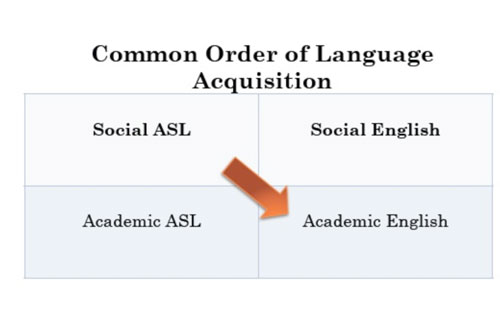Why Academic ASL Matters to Sign Language Interpreters
This is a presentation by Dr. Ben Bahan at StreetLeverage in Fremont, California in 2016. The video of the presentation is presented as well as an English translation. Though it takes more time to watch the ASL, I would recommend it is worth it to see such an excellent example of Academic ASL.
Dr. Bahan refers to the work of James Gee who is a social linguist and literary theorist who focuses on “Discourse” – differentiating between the primary Discourse a person learns in their family of origin and the “secondary Discourse” they learn in other settings. (Which connects to the idea of BICS/CALP described below. Read more about Gee’s work in his article “What is Literacy?”
Importance of Early Exposure to ASL
Henner et. al. American Sign Language Syntax and Analogical Reasoning Skills Are Influenced by Early Acquisition and Age of Entry to Signing Schools for the Deaf. Front. Psychol., 26 December 2016 | https://doi.org/10.3389/fpsyg.2016.01982
This article shares research about the impact of the age of acquisition of ASL for students. Importantly, it points out that early exposure to ASL is a benefit for both signing skills, but also cognitive development – which supports the acqusition of speech skills as well.
BICS/CALP
More information about Basic Interpersonal Communication Skills & Cognitive Academic Language Proficiency
- An article on BICS/CALP from the field of teaching English as a second language
- Information from Wikipedia on Professor Jim Cummins & BICS/CALP
- An ASL presentation of Kindergarten Readiness for Deaf students on ASLized.org
Learning English as a Second Language

The bottom graphic demonstrates what is often attempted for Deaf and Hard of Hearing students – which in part explains such poor results.
Academic ASL
 A blog supporting using ASL to developing BICS & CALP
A blog supporting using ASL to developing BICS & CALP- Resources from Gallaudet on ASL Composition
- ASL in Academics Lecture Series at Gallaudet
- Deaf Studies Digital Journal at Gallaudet University (The first journal published in ASL.)
- ASLized.org: This is a site designed to the promotion of ASL and provides ASL texts in a variety of genres.
A Video presentation of Dr. Raychelle Harris on Academic Discourse in English and ASL (Provided in ASL with English captioning)
The kick off lecture for the ASL in Academics Lecture Series
Use of Academic ASL in a High School Math Class
See the Mirrored Math resource.
Answers to Math Questions from Veditz
Posted in: "Interpreting Literature" Resources, "Putting FS on the Map" Resources, "TIPS-Light" Resources, In Service to Literacy, Mentoring Resources, Moving toward Best Practice, Sense of Place, Swiss Army Knife Tools

